Robert C. Lehman left an indelible mark on Eastern Mennonite University not only through his teaching — of physics, mathematics and astronomy from 1955 to 1980 — but also his firm commitment to and advocacy for the principles of sustainability.
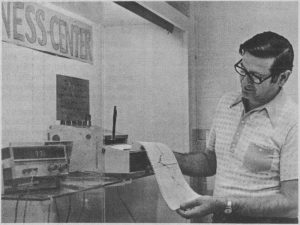
“I feel that you are one of the core of what I think a Christian Mennonite should be,” noted his daughter Judy Lehman ‘79 in a 1980 letter to her father. “Conservation in lifetime — you’ve studied it into a science.”
One of the first to advocate for conservation on campus, Lehman’s interest, passion and research led him to urge administrators to take action. That action eventually involved many in the physical plant and other employees who helped make EMC, and then EMU, a leader among Virginia higher education institutions in sustainability efforts, long before such concepts were common currency.
Lehman was not only principled and innovative, but also gracious. After being featured in a 1976 Daily News-Record article for his energy-saving measures at EMC, he wrote a letter to the editor, sharing the acclaim. “Mr. [Herman] Schrock [director of the physical plant] has been working diligently ever since the oil embargo to conserve energy at EMC and deserves far more credit for what has been done than is due me.”
As you will see, Lehman’s contributions to energy conservation were still certainly worth the recognition.
View a timeline of sustainability on the EMC/EMU campus.
Back to EMC in 1955
Lehman came from an established lineage of area Mennonite educators: his father was C.K. Lehman, dean as well as Bible and seminary professor. Two sisters attended and then taught at EMC, Miriam Lehman ’54 Weaver, in the business department, and Esther K. Lehman ’49, in education. His niece Dorothy Jean Weaver ’72 currently teaches at Eastern Mennonite Seminary. Another niece Carol Ann Weaver, recently retired from Conrad Grebel College, Waterloo, Ontario, taught music at EMC in the late ’70s.
A few years after graduating from EMC in 1950, Lehman attended a Mennonite youth convention in Kalona, Iowa, where he met Ruby Swartzendruber. After giving a mutual ride to the train station during the convention, he asked her to go out the next day – and the day after that, and the day after that for two weeks.
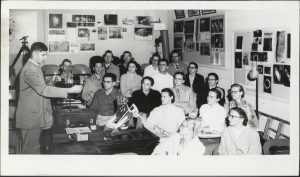
He got a job at a nearby turkey processing plant for those weeks, then spent the school year teaching at Franconia Mennonite School (now Penn View Christian School, Souderton, Pa.). Ruby started classes at Goshen College, alternating semesters with teaching stints, and Robert took a Mennonite Voluntary Service position in Iowa City. Ruby joined the service unit after they wed in 1954. EMC soon came knocking to offer him a faculty position and Lehman joined the science faculty in 1955.
Lehman helps design new Suter Science Center
While Robert taught at EMC and directed the Vesper Heights planetarium, Ruby worked as a teacher, earning her bachelor’s and master’s degrees at Madison College and her education specialist degree at the University of Virginia. Robert led a Sputnik sighting team in 1957 from Vesper Heights, which radioed in the second observational fix in the United States.
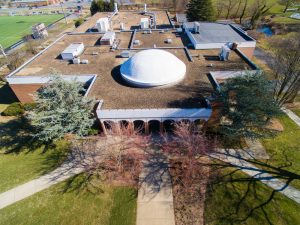
Lehman earned his master’s degree in biophysics in 1959 from Pennsylvania State University and continued his studies there as the first PhD student in the same academic program, graduating in 1962.
The Suter Science Center was completed in 1968. Lehman, who according to his former colleague John Horst played a role in its design, equipped the iconic domed Brackbill Planetarium with a state-of-the-art Spitz A-4 star projector. He hosted a showing of the Apollo 11 manned lunar mission on two televisions – one he had helped his eighth-grade son James build.
“The auditorium in the science center was completely packed,” says James Lehman. “People stayed all night until the ascent module lifted off.”
When not busy with academia, Lehman co-founded and was the first president of Park View Federal Credit Union, co-founded an alternative energy equipment supplier, raised four children and fielded many calls from radio stations and local residents, asking him to demystify unidentified flying objects.
Three of Lehman’s summers were spent in Penn State’s biophysics laboratory. His first sabbatical took the Lehmans to Atlanta, where he conducted cancer research at Emory University while Ruby taught social studies at a large, inner-city all-black high school. His second sabbatical became, arguably, his longest-lasting contribution to EMU: the first implementation of our environmental sustainability values.
Mending our ‘fuelish’ ways
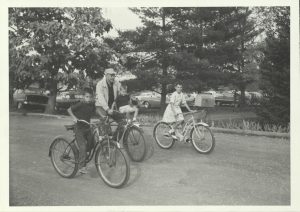
Lehman’s investigation into energy usage at EMC began in the ‘70s. In his personal life, he biked to and from work and made energy-saving modifications to his home, such as a solar water heater. Lehman shared these values with his children, who became amateur investigators themselves on more than one occasion.
In 1974, his oldest and youngest children (Judy, then 19 and Doug, 11) decided to help. Hunting for excessive energy use, they found a pavement crack between the library and chapel that was emitting heat. The two ran home for eggs and a skillet. Doug Lehman ‘85 continues:
We first tried to fry an egg in the skillet and then we fried one on the pavement, and it fried quite nicely … We wrote in bold letters on the cement, ‘This is a horrible waste of energy. Here is the egg that we fried on the pavement this evening at 7:42 p.m.’ We signed the message with the following: J. D. Norwich Investigators Internationale. This was the moniker my sister and I used for all of our clandestine operations at the time.
A leaky steam system was to blame, and days later, EMC began repairs.
Lehman’s interest led to a year-long sabbatical project in 1976-77. Through extensive study, he identified key areas of wasted energy: poorly designed heating and cooling systems, inefficient and unnecessary lighting, and uninsulated windows and piping. He built a mini-computer from a kit to control and monitor various energy systems on campus, and set up an “energy awareness center” in the science department. The display provided a calibrated meter read-out of EMC’s daily energy use.
This research prompted EMC, to make several infrastructure changes that resulted in savings of $66,000 in utility costs in one year. In 1978, the board of trustees awarded Lehman with a “resolution of appreciation” commending his “self-initiated energy research project.”
In a 1979 article titled “Mending Our Fuelish Ways,” Lehman wrote prophetically:
“Each of us who packs his schedule so tightly that he must drive one-half mile to school and from one building to another is demonstrating that efficiency is a higher priority than energy conservation … Are we willing to add an ‘energy plank’ to our present ethical platform?”
Today, it is clear that EMU has answered with a resounding “yes,” from our five-year Quality Enhancement Plan to our commitment to climate neutrality by 2035 to our growing track record of environmentally sustainable infrastructure and initiatives.
To Maryland and Goucher College
When the physics major was eliminated in 1980, Lehman was also let go, but not without considerable support voiced by his colleagues on campus and off. He had earned much community goodwill from his work as first president of Park View Federal Credit Union, as well with other community organizations, including serving as president for the Homes Foundation, which built residences for low-income families in Timberville.
Lehman did not stay unemployed long. Through the American Association of Physics Teachers, he met representatives of Goucher College (Baltimore, Maryland) and was soon hired there as a physics professor. Their children grown, he and Ruby moved to Maryland, where Lehman also worked for Howard County School of Technology.
In 1986, the Lehmans, with Frank ‘62 and Evelyn Nice, started the North Baltimore Mennonite Church in their living room, which now boasts 110 members.
The Lehmans returned to Harrisonburg in 1999. Shortly afterward, he was diagnosed with Parkinson’s, and eventually moved into the Oak Lea Nursing Home. Ruby recalls Robert looking inquisitively at an outlet in his room, and asking her to find out what energy-saving measures were being taken. Marv Nisly ‘68, then design and construction manager, provided a list from fluorescent lighting to thermal windows.
Robert passed away in 2009.
“If I were to describe my husband with a list of adjectives,” Ruby wrote in his memorial program, “I would say unpretentious, open, honest, inquiring, musical, loving, intelligent, grudge-free, other-worldly, practical, innovative, and LOGICAL.”
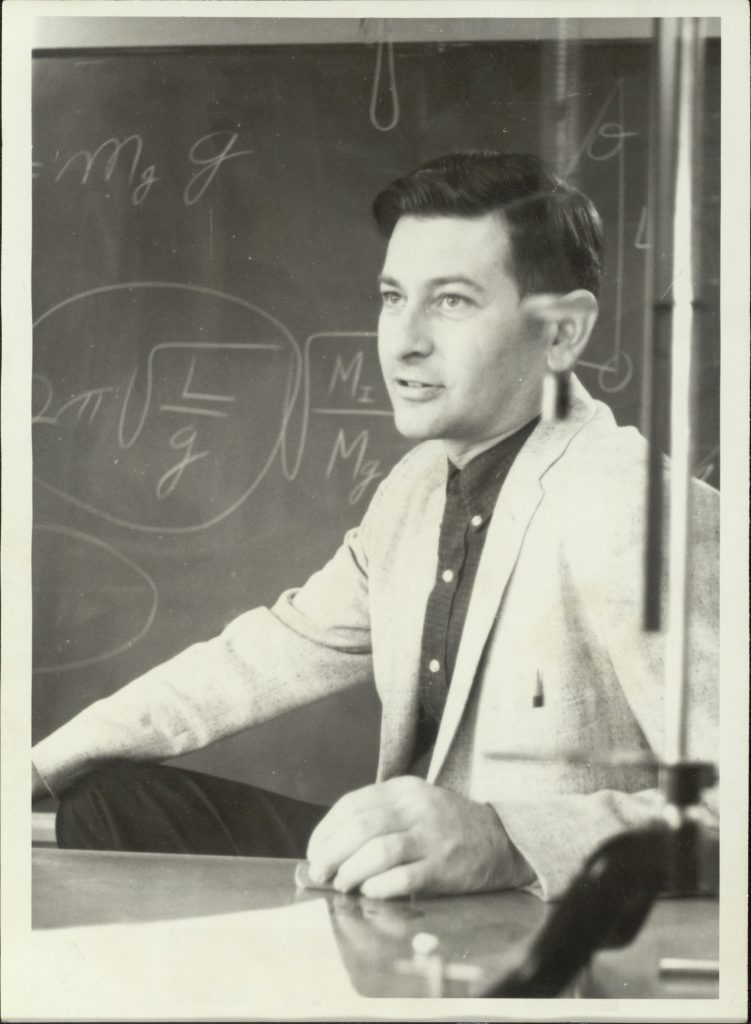
I count Robert as a mentor and supportive collaborator in the planning and implementation of many of the early energy conservation efforts that established a culture that continues to value conservation and sustainability. I well remember the fried egg and message on the pavement south of the Library.
Thank you for this delightful article that well articulates the importance, depth, and character of this special man.
I was one of the egg frying investigators. We children learned so many energy saving habits, like coasting up to stoplights. Once when my husband and I were driving from Harrisonburg to the Maryland coast for our annual family gathering, we were approaching the bridge to take us over the bay. We came upon a car which was coasting up to stoplights and braking as little as possible. I said that that car was driving like my Dad was in it……..It turned out to be him in their brand new car that I’d never seen! It turns out that little incremental savings really do add up.
Robert Lehman was one of my favorite professors. One day in physics class, he held a cat upside down a short distance above his demonstration table. He dropped the cat to show how quickly it could right itself!
I can’t think what cat would have allowed itself to come to class.
I’ve had the privilege of dining with Doug here in Washington D.C., and seeing Ruby’s smiling face many times at EMU. Thank you, Randi, for educating me and many others about Robert’s passion for sustainability!
This article made me think of the time that Father was called out to Broadway to inspect a large chunk of ice that had crashed through the roof of someone’s house. It landed just in front of the sofa where the residents were sitting at the time! I think that his assessment was that the chunk must have fallen off of a passing aircraft. But as I wonder about this, sitting here in Conakry, Guinea this evening, I’m wondering how it was that the people of Rockingham County somehow knew to call him for ice-through-roof type incidents. As was often the case, adventures like this were something I often participated in.
I also remember him saying that every time you use your brakes, you’re just throwing money out the window. I do wish taxi drivers worldwide would know this!
His findings from that ice incident and a few others were mentioned in a book about unusual happenings by Arthur Clarke.
I am grateful to EMU and writer Randi Hagi for this well written article about my husband. Many readers are probably wondering how a senior, tenured faculty member whose energy studies were creating so much interest on the EMC campus, could be “let go”. In fact, I was unaware of the full story until recently, when I uncovered a file containing Bob’s documents saved from that era.
The dean at that time gave the reason for Bob’s termination being that the Physics Major was being dropped, and Bob was to be the one that should be “let go”. The collected documents included letters to the dean from colleagues in the science department and other faculty, asking that he not be terminated. Bob served on a number of faculty committees, and had sent memos to the dean about ethics in the workplace, unfair treatment of some faculty members, lack of funding for academic programs in comparison to administrative initiatives, decision-making without due process, and much more. It is interesting to note a comment from the dean to a faculty member concerning Bob’s energy research. “Energy research, while fashionable, is not an area we can deploy our scarce resources in . . . . . We are a teaching institution and simply cannot take on assignments which large research universities can more appropriately carry.”
Fortunately for me, I was spared from being involved in my husband’s situation at that time, and able to pursue my much-loved teaching career and graduate studies. His primary support came from his loyal, trusted colleagues. I am thankful that our move to Baltimore was a positive experience for both of us . . . . . new teaching positions, new friends, enjoyable city life.
Our move back to Park View for retirement at VMRC was also a positive move, rejoining former colleagues and community friends. Bob would be so pleased to know that EMU has become a leader in sustainability and creation care! I love living next to EMU where I feel welcome, and can attend many campus events. I consider myself a part of the EMU Community!
Dr Lehman taught me physics in 1966. Through his creative teaching of the chapter on quantum physics I was able to imagine the possibilities of a God who was so much greater than my own experience. When asked years later how I came to believe in the Great God of the Universe, I replied,”thru a quantum physics class”.
I am still thankful that he inspired me to look up on starry nights.
All of you knew Bob as an academic and a marvelous scientist. And he was certainly that. As for me I knew of Bob as my friend as he and his wife Ruby were the first Mennonites I ever met in their house church in their living room on the Sunday afternoon on Dellsway Road on December 14, 1986. They were the face of Christlikeness that I met that afternoon
I am glad to have worked with Bob. We worked together to edit the cost of natural gas and fuel oil for the boiler plant. Load shedding of electric use on campus resulted in GREAT savings!
I have pleasant memories of my association With Robert (Bob) Lehman.
I had him for a teacher in General Physics in my sophomore year (1957-58)
and later as a colleague in the Math/Physics dept. starting in the Fall of 1967.
We were active in the design and running of the M.T. Brackbill Planetarium.
By the way he was also a good bass singer. Sang with the Park View Melodians
men’s quartet as a student from 1946-1852
Dr Robert Lehman was my physics professor. Through him, I learned how to save energy, pennies, and look forward to graduate school at James Madison University. Later Dr Lehman and Mrs Lehman adopted me as a lost Vietnamese child in this God’s country. He invited me every years to his family reunion with grandma Lehman. I am sorry we lost in touch when I moved to CA and heard that he passed away through this article. If you have the email address and phone mumber of Mrs Ruby Lehman, please let me know. I know The Lehman’s adopted a lot of international students at EMU and I have probably have a few dozen adopted brothers and sisters around the world that I have not met yet. All I can say the Lehmans are the gifts that God sent to International students and through them I learned and still believe in God. Their kids are wonderful too. They are just like their parents – Saving ENERGY and doing God’s work.
Learning of other sides of Bob is an inspiration. Much of what he and Ruby taught me, in the most informal of settings in Baltimore, continues in the Boston-area choir where I now sing and in the Quaker circles where I worship and serve. I’m ever so grateful for their presence.
Bob and I were classmates at then EMC. We were the only two majoring in physics and mathematics. He and I studied together and to do this I went to C. K. Lehman’s residence. I was such a frequent visitor to the C. K. residence that one of the granddaughter (I forget her name) called me the study-boy. Our paths diverged and I when I finished my IW term I went to work for a multi-national oil company as a scientific programmer doing refinery simulation in the Economic Planning Department. Following several years of this I became restless and bored and transferred to the U of D Department of Computer Science & Statistics. A very wise and kind professor at the U of D help me to obtain a National Science Faculty Fellowship which I spend at Johns Hopkins University. Here our paths converged again and we spent quite a bit of time together and I recall he and Ruby both taught in one of the HS in the Baltimore Area. I am aware of the may talents Bob had and am impressed at the mark he made at EMC and the many students whose lives he touched.
Just an aside, I have spent more that 35 years in a state university and know the politics used to get rid of a professor and the surest route is to eliminate the department. I am aware that the same technique was used to ‘get rid of Bob’ which saddens me.